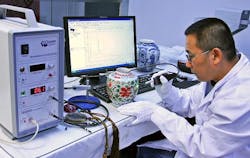Dunedin, FL--Technology from Ocean Optics is being used in China's Beijing Antique City to separate authentic ceramic antiques from fakes. Nationally recognized antiques appraiser Guan Haisen uses an Ocean Optics laser-induced-breakdown spectroscopy (LIBS) system and spectrometer to help him identify artificially aged ceramics and artifacts.
Ocean Optics' LIBS system uses a laser to ablate a small area (invisible to the naked eye) of the object under test, forming a plasma. The plasma is then analyzed for the key elements of interest, such as chemicals used to simulate the process of aging. The entire test takes less than 30 s.
Currently, the ceramics examination industry in China relies heavily on the appraiser's knowledge and experience. LIBS analysis brings a level of technical accuracy to antique identification. Haisen uses LIBS to augment his extensive expertise and obtain the most accurate results. His goal is to make this type of scientific verification a standard practice.
Ocean Optics' flexibility enabled Haisen to design a new configuration of the LIBS system--basically an entirely new product specifically for his needs.
Haisen is a nationally recognized expert in distinguishing fake antiques, particularly ceramics. He has published a number of books and papers on the subject, and has appeared on numerous television shows, including the Chinese equivalent of Antiques Roadshow.
About the Author
John Wallace
Senior Technical Editor (1998-2022)
John Wallace was with Laser Focus World for nearly 25 years, retiring in late June 2022. He obtained a bachelor's degree in mechanical engineering and physics at Rutgers University and a master's in optical engineering at the University of Rochester. Before becoming an editor, John worked as an engineer at RCA, Exxon, Eastman Kodak, and GCA Corporation.

